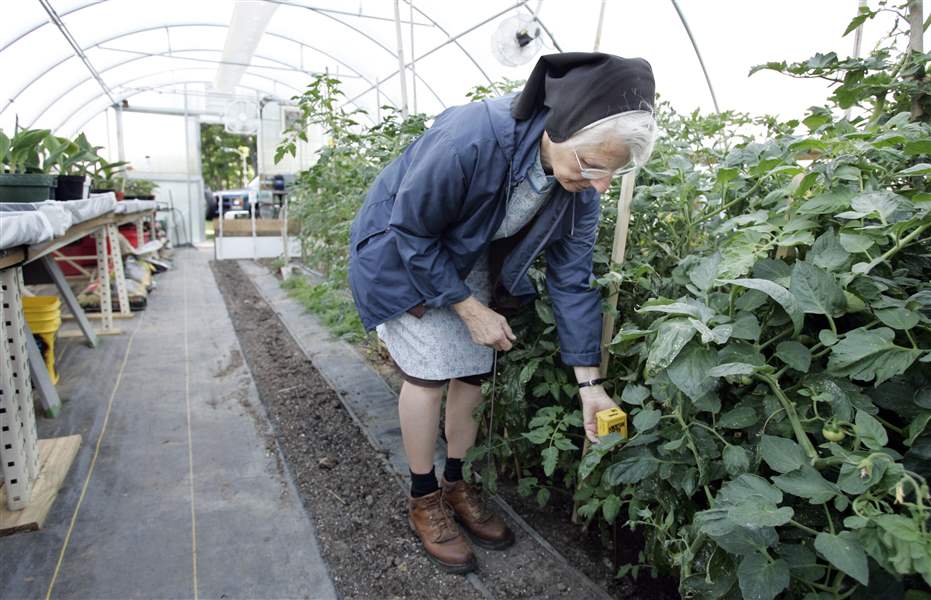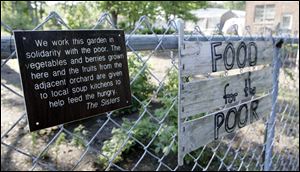
Sylvania nuns are feeding the hungry year-round
6/27/2009
Sister Grace Ellen checks the soil temperature and moisture content in the greenhouse the Sisters of St. Francis built.
The Blade/Dave Zapotosky
Buy This Image

Sister Grace Ellen checks the soil temperature and moisture content in the greenhouse the Sisters of St. Francis built.
Every fall since 1992, when the Sisters of St. Francis of Sylvania would harvest their last crop of fruits, vegetables, and berries from their gardens and take them to a soup kitchen in East Toledo, Sister Jeremias Stinson would feel a sense of frustration.
Here she was in Ohio, she said, a state rich with fertile farmland, and it was impossible to grow crops from October through spring because of cold weather. Yet the need to feed the poor doesn't stop when winter arrives.
"We are in the bread belt and the state of Ohio is third in the nation for hunger. It doesn't make sense," Sister Jeremias said.
"We'd take our last little load to the Helping Hands of St. Louis kitchen for the poor and see the long lines of people," she said. "And my whole idea was that there has to be a way that we can continue to grow crops and feed the needy."
Sister Jeremias and her colleague, Sister Grace Ellen, decided they wanted to find a way to beat Mother Nature.

The Sisters of St. Francis decided to feed the needy by growing food all year long.
With help from numerous volunteers and experts who provided labor, financial and material donations, and advice, the two Catholic sisters last fall built a 48-by-20-foot Quonset hut-style greenhouse on the nuns' 89-acre Sylvania campus.
The project proved to be a success, producing several healthy crops of tomatoes, squash, carrots, onions, potatoes, lettuce, broccoli, and more in the midst of one of the coldest winters in Ohio history.
The greenhouse features pipes laid 15 inches below the surface, circulating warm water to keep the soil at 70 degrees so the plants' roots will develop.
The air in the greenhouse is also kept at a consistent 70 degrees.
Sister Grace and Sister Jeremias keep detailed logs of the soil and air temperatures as well as soil acidity to make sure all systems are functioning properly.
They pointed to their entry of Jan. 12. When Toledo's temperatures plummeted to 20 degrees below zero, it was a toasty 68 in the greenhouse.
The nuns use minimal amounts of chemicals on their crops, preferring to control the pests with natural herbs, netting, and even hot peppers.
They use solar heat as much as possible, switching to electrically powered water and air heaters, controlled by thermostats, when necessary.
The Quonset hut's plastic exterior, with two thin layers separated by a cushion of windblown air, had to be covered with whitewash because the interior of the greenhouse got too hot this spring, Sister Grace said.
When it reached the mid-60s in March, the greenhouse hit 100 degrees inside. The whitewash on the outside diffuses the sunlight and can be washed off in the fall when solar heat will be needed.
Every step of the way, it seemed, hurdles would pop up and the sisters would find ways over or around them.
In January, the well water was a frosty 40 degrees. So the nuns installed a reservoir tank and set up an array of black pipes on the south wall that soaks up the sun's rays. That system is backed by a water heater for days when it's cloudy and cold.
The sisters also put in a circulating pump, much like a pool pump, that keeps the water flowing through the network of underground pipes.
A thin wall of insulation was installed around the bottom of the greenhouse and down under the surface, to prevent "a feast for the nation of wildlife," Sister Jeremias said.
"I've gone from Plan A to Plan B and I've already gotten to Plan C in some instances," she said.
The sisters have met with U.S. Rep. Marcy Kaptur (D., Toledo) several times to keep her apprised of their progress, and they have also keeping in touch with local agricultural and education officials.
The nuns also bring in young schoolchildren to teach them about growing plants and vegetables.
"I ask them what if Kroger's is closed and your refrigerator is empty," Sister Jeremias said, "could you feed yourself and your family?"
The greenhouse on the Sylvania Franciscans' campus cost about $5,000, but a bare-bones version could be built for $3,500, the nuns said.
The sisters envision similar greenhouses being set up in needy neighborhoods so the poor can grow their own food year-round.
But they also hope that their small-scale project will lay the groundwork for some big group or company to take their ideas to the next level.
"If we could do a little itsy bitsy thing and work the kinks out and complete the experiment and be able to say this does work, then someone else on a larger scale can afford to take this concept and move forward," Sister Jeremias said. "We're maxed out with the two of us doing all the work."
Contact David Yonke at:
dyonke@theblade.com or
419-724-6154.